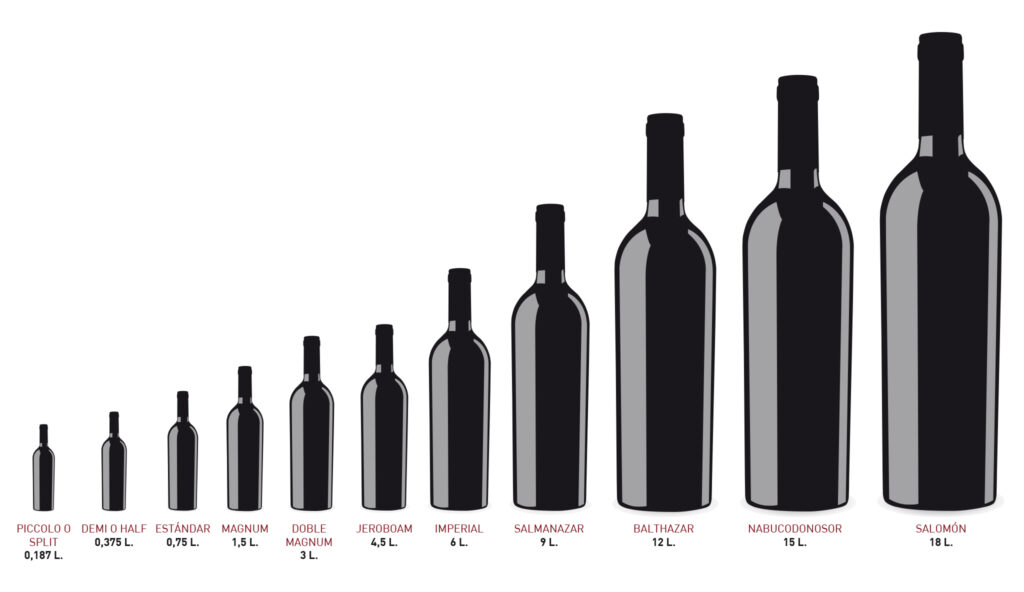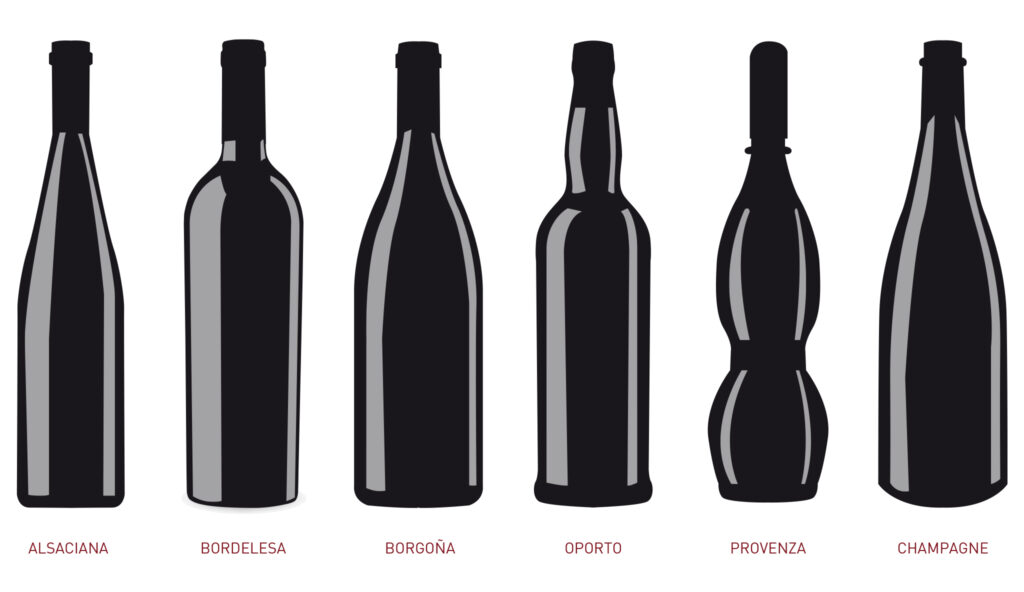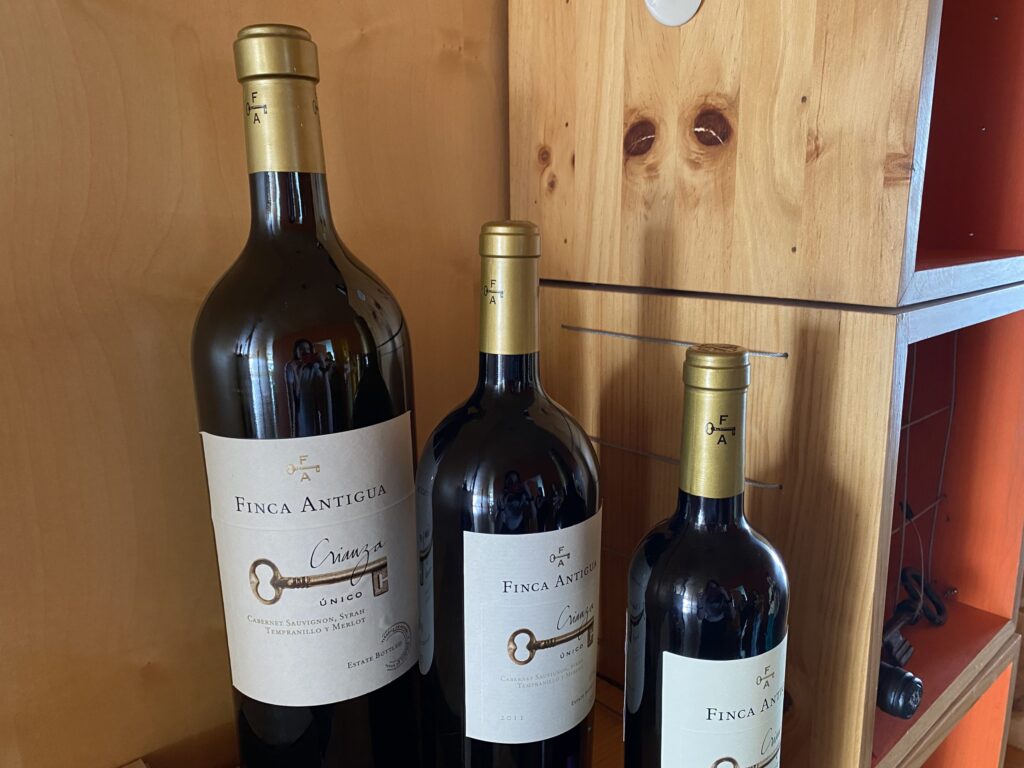If we talk about the size and shape of wine bottles, we have a catalog of 12 different sizes and 6 types of bottles, all of them with their picturesque names, peculiarities and characteristics.
Although it may seem secondary, the size and proportion of the bottles affects the evolution of the wines. For example, in smaller bottles the aging process is accelerated, while in larger bottles there is a lower concentration of oxygen, reducing the impact of possible thermal variations and resulting in more harmonious aging.
What are the sizes of the different wine bottles?
Below, we share a list, in order from smallest to largest and their different forms:
- Piccolo or Split: It is the smallest size, with a capacity of 18.7 cl. It is generally used in the hospitality industry and in individual services in the field of transportation.
- Demi or Half: Equivalent to half a bottle of wine with a capacity of 37.5 cl.
- Standard: This is the bottle that we usually find for sale, the one that is most commonly seen and used. They have a capacity of 75 cl.
- Magnum: With a capacity of 1.5 liters, it is equivalent to two standard bottles of wine.
- Double Magnum: As its name suggests, it is equivalent to double the previous size, so that it covers a total of 3 liters, equivalent to four standard bottles.
- Jeroboam: It has a capacity of 4.5 liters for a still wine. For sparkling wines, a Jeroboam is equivalent to the capacity of a Double Magnum. When it is a 4.5 liter bottle for sparkling wines or Champagne, the bottle is called Rehoboam.
- Imperial: Collects a total of 6 liters, containing the equivalent of 8 standard bottles of still wine. In the case of sparkling wine, it is called Methuselah.
- Salmanazar: Contains 9 liters, equivalent to 12 standard bottles.
- Balthazar: Its capacity is 12 liters and is equivalent to 16 standard bottles.
- Nabucodonosor: Carries a total of 15 liters, equivalent to about 20 standard bottles.
- Salomon: This is the largest size, collecting 18 liters, which is equivalent to 24 standard bottles.

What are the shapes of the wine bottles?
There are 6 different shapes of wine bottles. This is due to the variety of traditional glass blowing methods depending on the geographical area where they were made.
Their names are related to the wine regions where they were developed and originally used to store wine.
We tell you about it:
- German shepherd bottle: It is a taller and thinner bottle than other types, with slightly sloping shoulders. These bottles generally contain Riesling grapes, and can be brown if the grape is French, or green if the origin of the grape is German. It is also known as Germanic bottle.
- Bordeaux bottle: With a cylindrical body, straight sides and high shoulders, this is the most common shape. It comes from the city of Bordeaux and was traditionally used for blends of Cabernet Sauvignon and Merlot, but nowadays most of the world’s wines use this bottle shape.
- Bottle of Burgundy: This bottle has a shape reminiscent of a cone, due to its sloping shoulders and a higher neck than the Bordeaux bottle. It is traditionally used for Chardonnay, although it is increasingly common to use it also for Sauvignon Blanc and Pinot Noir.
-
- Bottle of port: This shape resembles the Bordeaux bottle, but its neck has a spherical protrusion in order to trap excess sediment during pouring. As its name suggests, it is a form intended for Port, Sherry, Madeira and other fortified wines.
- Bottle of Provence: These bottles are reminiscent of an hourglass or a bolo, as a narrowing of the shape can be seen in the middle of the bottle. This form comes from Côtes de Provence, a region with a strong tradition in the production of rosé wines.
- Bottle of Champagne: These bottles are similar in shape to Burgundy bottles, but heavier and thicker because they must withstand the high pressure resulting from sparkling wines. They are used for champagne and other sparkling wines such as cava or prosecco.

In short, there is a bottle for every wine and a wine for every bottle. If you visit our
farms
or the
online store
you will be able to discover the different sizes and shapes we use in our elaborations.




